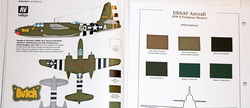Indoor Free Flight
By Don Slusarczyk | [email protected]
As seen in the May 2025 issue of Model Aviation.
I had heard about people using Vaseline to attach OS film to the holding frame when covering flying surfaces, but I had never tried it. I had aways used spray adhesive to attach the film to the holding frame. My process was to roll some film out on a large beach towel, spray the holding frame with 3M Super 77 multipurpose spray adhesive, and then lay the frame on the film to attach it. The one issue with this method has always been that the film is rather tight on the frame, and some slack in the film is needed when covering things such as a wing or tail.

Because I am also accustomed to covering with microfilm (which is also tight on the holding frame), my solution for OS film was to just copy what I had been doing with microfilm by using thin masking tape (either 1/4-inch or 1/8-inch wide) and taping just inside of the inside edges of the holding frame. I would then cut the film between the tape and frame to get some slack in the film. This method has worked great for me throughout the years.

I recently had the wing and tail to cover on a new Pennyplane and decided to try the Vaseline method. It was freezing cold and snowing and I did not want to go outside to spray the holding frame with spray adhesive.

I dipped my finger into the Vaseline jar then spread it around the holding frame outline to give it an even coat. As per my normal routine, the OS film was spread out on a beach towel and I placed the holding frame on top, where it stuck rather well. Instead of using masking tape to slacken the film, I used two fingers and "pushed" around the edges of the frame to get slack into the film. The pushing causes the film to slip slightly in the Vaseline, creating the slack.

After I placed the wing on the film, any wrinkles in it were then corrected by using my fingers again to push or pull where needed for a uniform look. This is a much more controllable method compared with the masking tape that I had been using for so many years. I then finished covering my Pennyplane wing and tail using diluted 3M Super 77 that was brushed around the flying surface outlines.

Going forward, I will be using this method for attaching plastic to the covering holding frame. Vaseline is not the only product that can be used successfully. I know some who have used Chapstick instead, and they report that it works just as well. I imagine any thick petroleum-based product will work just fine.
Until next time, keep the weights down and the times up!
Larry Loucka

IT IS WITH great sadness that I report to the Indoor Free Flight (FF) community the passing of longtime Indoor FF modeler Larry Loucka. Larry and my father routinely competed together in Indoor FF, Outdoor FF, and Control Line in their youth. I first met Larry when I was 12 years old, at the first Indoor FF contest that I attended with my father. He became my friend for more than 40 years.
When I was a teenager, he made copies of all of his building and construction notes, as well as wing, tail, and propeller templates for the models he flew, so that I could get a jump start into competitive Indoor modeling. He always shared his building techniques and model-trimming methods.
Although we competed against each other on countless occasions throughout the years, it was always with a level of mutual respect and with good "competitive" spirit. There were multiple times at contests, such as the Nats or US Indoor Championships, when Larry would dig into his motor box and pull out a rubber motor to lend to my dad and me that was the same size as one that broke while we were trying to get in a last-minute official flight before the contest ended. He was a sportsman in the truest sense, and his tool box always seemed to have the right tool for anything and everything that needed a quick field repair.
Those who met Larry know that he had a keen talent for storytelling. His ability to recall events and details of past contests and modelers made him a unique character in the Indoor modeling community. He was a great modeler, craftsman, mentor, competitor, and friend, and will be truly missed by the Indoor FF community.
SOURCES:
National Free Flight Society (NFFS)







Comments
Add new comment